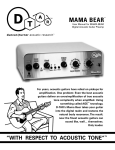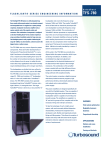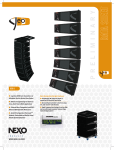Download Meridian 541 Product manual
Transcript
PRODUCT MANUAL MERIDIAN MICROPHONE FOR ACOUSTIC GUITAR Thank you for purchasing the K&K Meridian Microphone! This manual covers installation and use for the Meridian and Meridian Pro Microphone systems for acoustic guitar. INSTALLATION INSTRUCTIONS FOR ACOUSTIC GUITAR Separate the two clamp parts. They are held together by Velcro. Bend the bottom part to fit the exact shape (angle) of the guitar body. This might not be a right angle, depending on the guitar model. T i g h tl y press the 2 clamp parts towards each other while snapping the Velcro together. If done properly the non-slip padding will now hold the clamp and mic securely to the instrument. On an Archtop guitar the top part needs to be adjusted/bend to the fitting angle as well. Align the top part of the clamp (the part with the mic) over the bottom part without snapping the Velcro together. 92798 Cape Arago Hwy, Coos Bay, OR 97420 | 541-888-3517 | Toll Free 1-800-867-6863 | www.kksound.com 2 I f yo u n eed to ti g h ten th e c l amp , loosen the bottom clamp part to one side but leave it attached at the edge by the Velcro (see the phot, right). Move it up by 1/16” and press the Velcro back together. Slide the assembled clamp/mic back onto the guitar. MICROPHONE POSITION To start, position the mic as shown in the photos below. Aim it more towards the sound hole for more bass or more towards the 14th fret for a tighter and brighter sound. positioning that minimizes unwanted handling noise. We also found the sound quality superb for recording. You can move the mic closer to the sound hole or away from it to control the amount of bass. To cut down on cable handling noise and for extra strain relief please wrap the cable under the clamp as shown below. REMOVAL AND TRANSPORTATION Remove the mic by pulling the assembled clamp/mic off the guitar. If you want to leave the clamp on the instrument, carefully remove the mic from the little clip on the clamp. W e s el l the c l amp i ndi vi dual l y. For a quick change from one instrument to another leave the clamp on the guitar and buy another clamp or your second instrument. You can easily remove/snap-on the microphone itself with the little clip on the clamp. ALT E R N ATE PO S I T I O N Please note that the foam windscreen sits snug on the guitar top with some pressure from the gooseneck that holds it down. This is a very quiet Please slide the supplied protective tubing over the windscreen before you put your mic into the box. This protects the windscreen foam and ensures it holds its shape. If you are using the microphone and clamp on multiple guitars, please follow the complete 92798 Cape Arago Hwy, Coos Bay, OR 97420 | 541-888-3517 | Toll Free 1-800-867-6863 | www.kksound.com 3 installation instructions for each separate instrument to ensure that the clamp fits tightly and precisely. MERIDIAN PREAMP Your Meridian Preamp comes factory-preset with the mid-frequency control system fully activated, which means the midrange is cut by 16dB. We find this setting to sound very elegant and “studio like”. You can adjust this control with a small precision screwdriver. Turn it clockwise to increase midrange. Connect the microphone to the Mi c I n and use an XLR microphone cable to connect the preamp’s O U T to an XLR input of a PA or amp. The preamp works on phantom power via the XLR output, or with a suitable 12 volt DC power supply (100mA, DC connector center plus). Start with both- bass and treble EQ on your amp/PA turned all the way down. Then add frequencies to your liking. MERIDIAN PRO PREAMP The Meridian Pro Preamp handcrafted at the K&K facility in Oregon/USA to extremely low noise specifications with excellent clarity and warm EQ. It is optimized for the use with the Meridian Microphone. Plug the mic in the I N P U T and connect the LINE or XLR OUTPUT (or both) to an amp or PA system. consumers are connected to a mixing board, the power may drop down below a sufficient supply voltage for the Meridian Pro Preamp. The battery will be activated only in case the phantom power gets too low but it will not be discharged as long as Phantom Power is higher that the battery voltage. The LED light on the front-panel indicates if phantom power is present. In order to save battery it will not light when the unit works on battery power only. Always turn the volume on the PA or amp channel OFF before you plug the XLR cable in/out the preamp or the mixing board/amp. If you don’t, the loud crack in combination with a phantom power spike might damage the preamp’s op-amp! C HAN G I N G THE B ATT ER Y To insert and change the battery, open the 2 screws on the sides of the unit, remove the lid, connect a fresh 9 volt battery to the battery clip and place it in the marked compartment. The unit is delivered without a battery. ALWAYS UNPLUG THE INPUT CABLE IN ORDER TO SWICH OFF THE BATTERY when the unit is not in use! ADJU S TI N G THE S O U N D W I TH THE PR EAMP We recommend to start with all EQ controls turned down all the way and add frequencies to your liking. Then listen to the two phase switch settings to get the best tone and the lowest feedback. But first, please read the following paragraphs: ADJU S TAB LE G AI N C O N TR O L Gain and volume do both have an effect on the output volume of the preamp but they accomplish different tasks. The gain (also called input gain or sensitivity control) controls the input signal level in the circuit in the preamp. It sets the amount of preamplification before the signal enters the EQ section etc. The volume control on the other hand is located at the end of the circuit and simply allows lowering or shutting down the volume. The Meridian Pro Preamp operates on industry standard Phantom Power or one 9-volt battery. We recommend having a 9-volt battery installed in the unit at all times. Phantom power drops down considerably under load. If several phantom power It is very important to properly set the gain control to fit the instrument you are using. An instrument with a high volume will require less gain than one that is not as loud. Also a player who strums hard 92798 Cape Arago Hwy, Coos Bay, OR 97420 | 541-888-3517 | Toll Free 1-800-867-6863 | www.kksound.com 4 will have to set the gain lower than one who picks the strings very lightly. To set the gain correctly, you have to mount and connect your mic to the guitar and plug it into the Meridian Pro Preamp. Connect it to your amplification system and set the channel to a low volume setting for a start. Begin with the gain on the preamp at about 12 o’clock center setting. The volume control on the Meridian Pro Preamp should be set to fully clockwise. Play your instrument in your loudest dynamic range (play it as hard as you expect to play) and slowly turn the gain up until distortion just occurs. Now back the gain off a little bit until the signal is clear again. This is the correct gain setting for this instrument. With the Meridian Microphone the gain will most likely end up somewhere between “half” and “full”. Please keep in mind that excessive EQ boost applied after the initial gain setting procedure may introduce distortion, in this case you have to reduce the gain a little bit. the acoustic instrument will fight its own amplified sound and no balanced tone can develop. Round and warm tone is only achieved when acoustic and amplified sound oscillate in the same phase. The Meridian Pro Preamp’s phase switch allows for instant correction of this problem. Play your instrument and flip the phase switch back and forth. You will experience a fuller and warmer tone one way or the other. O U TPU TS The active DI XLR output and the line output can be used simultaneously. Like this the 1/4" line out can conveniently be used as a monitor out or for connection to a tuner while the unit is connected to the PA via the XLR out. You can of course use each output individually. The Meridian Mic can also be used with the K&K Quantum Blender. The microphone itself does not work on 48V phantom power! It is powered with 5 volts by the preamp. P HAS E S W I T C H Phase switches are usually marketed as a feedback controlling device, but they accomplish more than just that. What is phase? Phase determines at what point in time a sound wave has it’s peak or trough. This picture shows 2 simple (identical) sine waves, but the wave on the bottom (2) is inverted in respect to the wave on top (1). Interestingly, if these two waves were played back simultaneously, they would completely cancel each other out and no sound would be heard. Amplification systems and effect units may or may not invert the phase in respect to the signal which is send in. In most cases the manufacturers do not specify. Every acoustic instrument projects (acoustic) sound waves in a certain phase. The phase that is projected from the amplified speaker source should be "in phase" (not inverted) with the acoustic instrument's own sound waves or the result will not be optimal. If the amp projects the inverted phase, 92798 Cape Arago Hwy, Coos Bay, OR 97420 | 541-888-3517 | Toll Free 1-800-867-6863 | www.kksound.com 5 TECHNICAL INFORMATION Polar Pattern MERIDIAN MICROPHONE Frequency Range: 30 - 18,000 Hz Sensitivity: 7 mV/PA/1 kHz Maximum SPL: 142dB Polar Pattern: Unidirectional Mic Power requirement: 5 Volt DC (supplied by Meridian preamp or K&K Quantum Blender) Cable 8 feet Technical Information Meridian Microphone Preamp Input: ¼ mono with 5-volt DC lavalier mic power supply Output: XLR active balanced Midrange control: +/-20 dB - super wide band Q Power requirements: 12-48 Volt phantom power or 12 volt DC 100mA MERIDIAN PREAMP Input: 1/4" mono with 5-volt DC lavalier mic power supply Output: XLR active balanced Midrange control: +/-20 dB - super wide band Q Power requirements: 12-48 Volt phantom power or 12 volt DC 100mA MERIDIAN PRO PREAMP Input: ¼ mono with 5 volt DC lavalier mic power supply Output 1: XLR active balanced – 8K Ohm Output 2: Line – 100 Ohm Bass control: +/- 20 dB - 100 Hz high pass Midrange control: +/-20 dB–1.5K super wide band Q Treble control: +/- 20 dB – 10K Power requirements: 12-48 Volt phantom power or 9 volt battery Frequency response curve - Microphone SPECIAL NOTE REGARDING PHANTOM POWER The Meridian preamp works on 12-48 volt phantom power or on 12VDC power via a suitable power supply like the one we sell for this microphone system. Phantom power is unfortunately not 100% standardized and differs in respect to how clean and hum-free it is. “Dirty” phantom power may introduce a more or less noticeable hum into the signal and when connected to preamp devices, the preamp circuit naturally amplifies this noise. In situations you need studio quality noise specifications we recommend to power the Meridian preamp with its designated 12VDC power supply and switch the phantom power supply off. This will guarantee noise free operation. 92798 Cape Arago Hwy, Coos Bay, OR 97420 | 541-888-3517 | Toll Free 1-800-867-6863 | www.kksound.com














